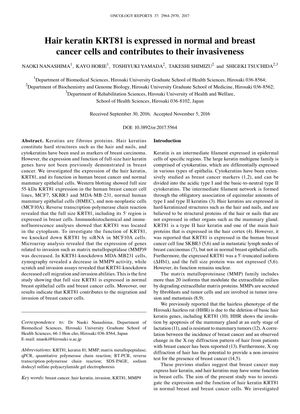TLDR The hair keratin gene KRT81 is found in both normal and breast cancer cells and helps them invade surrounding tissues.
The study from April 11, 2017, demonstrated for the first time that the hair keratin gene KRT81 is expressed in both normal breast epithelial cells and breast cancer cells. The researchers found that the full-size 55-kDa KRT81 protein was present in various human breast cancer cell lines (MCF7, SKBR3, MDA-MB-231), normal human mammary epithelial cells (HMEC), and non-neoplastic cells (MCF10A). They confirmed the expression of the full-size KRT81, including its 5' region, in these cells. Localization of KRT81 was identified in the cytoplasm through immunohistochemical and immunofluorescence analyses. Functional studies involving siRNA-mediated knockdown of KRT81 in MCF10A cells showed a decrease in the expression of genes related to invasion, such as MMP9. Additionally, reduced MMP9 activity and diminished cell migration and invasion abilities were observed in KRT81-knockdown MDA-MB231 breast cancer cells. These findings suggest that KRT81 plays a role in the invasiveness of breast cancer cells.
35 citations
,
April 2008 in “Journal of Biological Chemistry” Hirosaki hairless rats lack hair due to missing DNA with key keratin genes.
23 citations
,
October 2007 in “International journal of cancer” X-ray diffraction of hair might help detect breast cancer non-invasively.
17 citations
,
October 2005 in “Journal of Biological Chemistry” Early involution in Hirosaki hairless rats' mammary glands is linked to a unique modification of STAT5A.
276 citations
,
January 2005 in “International review of cytology” More research is needed to understand how hair keratins work and their role in hair disorders.
18 citations
,
September 2003 in “International Journal of Cancer” EBV infection increases a specific keratin variant in carcinoma cells, possibly affecting cell structure and cancer progression.
272 citations
,
September 2001 in “Journal of Biological Chemistry” Human hair keratins were cataloged, showing their roles in hair differentiation stages.
8 citations
,
June 2001 in “Journal of Biological Chemistry” A truncated protein linked to breast cancer may change cell adhesion.
14 citations
,
December 1998 in “British Journal of Cancer” Truncated hHb1 keratin may play a role in breast cancer cell transformation.
 October 2024 in “Frontiers in Veterinary Science”
October 2024 in “Frontiers in Veterinary Science” FKBP10 and FBN2 are key proteins for hair growth in cashmere goats.
 242 citations
,
February 2016 in “Science”
242 citations
,
February 2016 in “Science” Hair loss and aging are caused by the breakdown of a key protein in hair stem cells.
 27 citations
,
June 2023 in “Nature”
27 citations
,
June 2023 in “Nature” Senescent melanocytes can boost hair growth by activating hair stem cells.
7 citations
,
January 2020 in “The journal of investigative dermatology/Journal of investigative dermatology” NIPP1 is important for healthy skin and could help treat skin inflammation.
 47 citations
,
June 2019 in “Nature Communications”
47 citations
,
June 2019 in “Nature Communications” Noncoding dsRNA boosts hair growth by activating TLR3 and increasing retinoic acid.




